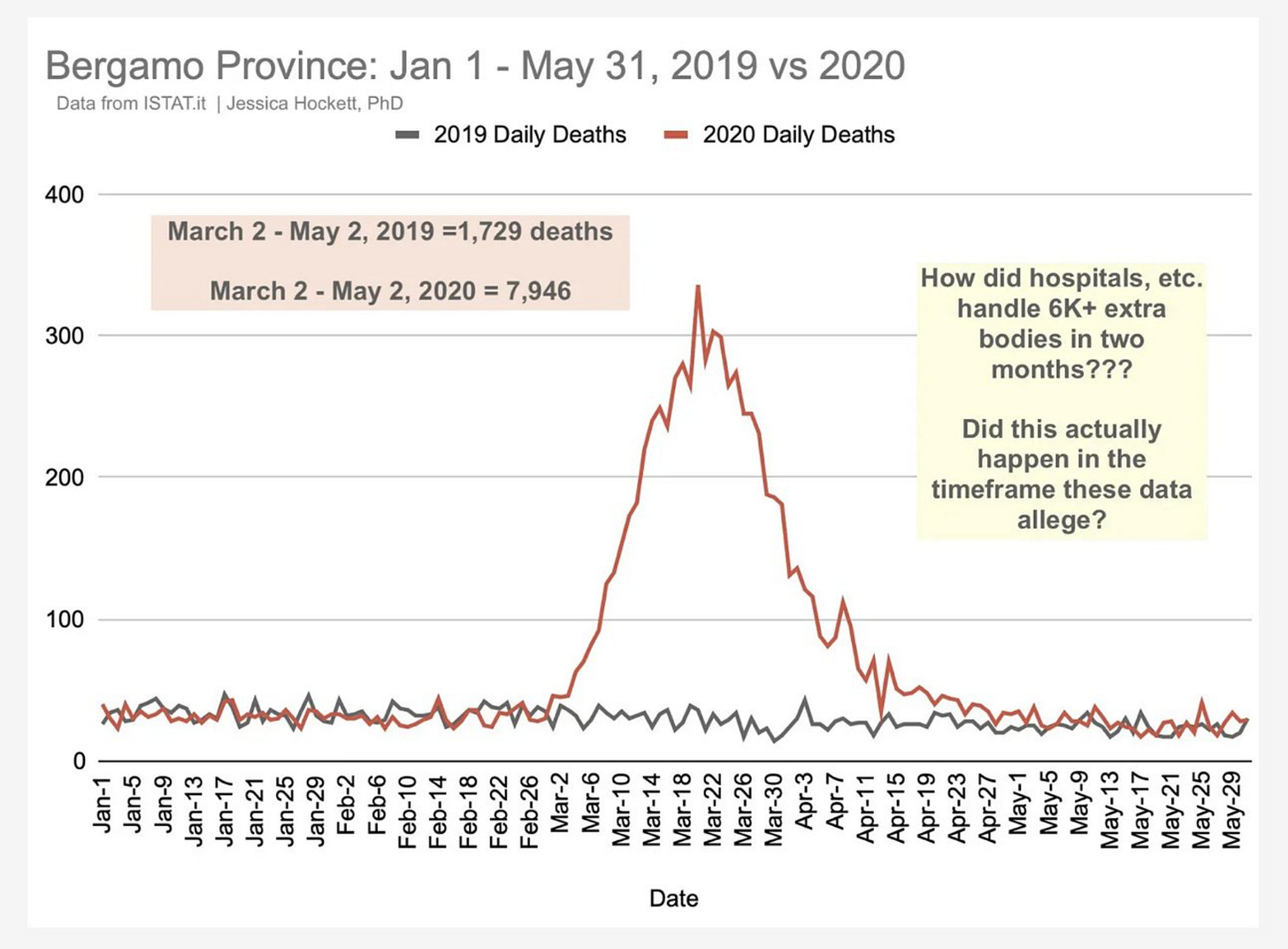Initial reaction to Tom Lausen's claim regarding Bergamo cemetery data substantiating the spring 2020 death spike
In November 2024, German data analyst Tom Lausen said he suspected the Bergamo province death spike to be “fake,” due to the absence of a pull forward effect.
Having already said that I considered the Bergamo event curve to be manipulated,1 Lausen’s presentation motivated me and
to acknowledge Lausen’s suspicions and state more formally why we believe the official data are fraudulent.Subsequent articles reinforce and extend the points with
comparisons to Hurricane Katrina and a similar-sized county in the U.S.,
closer scrutiny of claims made by media and local officials, and
signs that the curve is more modeled than measured.2
Now it seems that Lausen has reversed course and believes the data are showing a real-time event. In response, I address what he has said based on my understanding of his most recent statements. I will amend this article or write a follow-up if my interpretation is incorrect or if Lausen and his colleagues share their analysis in written form. [UPDATE, 23 July 2025: As far as I know, Tom Lausen and colleagues have not yet shared their findings in written form.]
Cemetery Visits
In a 7 May 2025 presentation to the EU Parliament, Tom Lausen reported that he and a team spent ten days in Bergamo in order to count graves.
Now many other critical people have said maybe this really large spike in Bergamo may have been a data manipulation & I’ve also thought about that as a theoretical explanation. And that’s a key reason why I resolved to go and count gravestones in Bergamo.
We went there in April, we visited 27 cemeteries in and around Bergamo city, we hand counted every gravestone & there can be no question of faking it here because you see the names, dates & photos of the deceased.
And with a decent 17% sample size we verified the Eurostat numbers are real, these people died.
Lausen’s graphs are shown below. The first appears to be quarterly, the second is weekly.
According to a summary provided by Howard Steen
deaths were recorded for the years 2017 to 2025
in 2020 weekly deaths were recorded in the critical weeks 9 to 18
the age of death was noted
twenty-seven cemeteries within the Bergamo province were surveyed
the survey sample represents 17% of cemeteries in the province
Per data from the Italian Statistical Authority, there were 7,946 deaths in Bergamo Province between March 2-May 2, 2020, which is roughly 6,000 more deaths than occurred during the same weeks in 2019.
Questions
My questions follow:
If Lausen’s team went to 27 cemeteries (17%) of 159, how could their count substantiate the toll? What proportion of all burials do those 27 cemeteries comprise? How many graves did they count? Thousands? Are they extrapolating from the 27 to the 159? If so, on what basis?
Where is the raw data collected that shows the dates of death and the number of graves counted in each location of people who died on that day? A curve that is fraudulent is distorted in magnitude, timing, or both.3 If 200 deaths are reported for one day but only actually 100 occurred on that day, the curve is false.
Were names recorded? Can the individual names, ages, birth/death dates be made public for verification/corroboration purposes?
Do Bergamo municipalities keep burial permit or other records? What about cremations? Were these checked and can they be obtained and released?
There were reports of decedents being moved for burial to other provinces — how are these accounted for?
If Tom Lausen has responded to or integrated the points raised by Jonathan Engler and me in our individual or joint articles on the Lombardy/Bergamo events, it has not been brought to our attention.
For obvious reasons, analysts from different countries and languages can struggle to fully grasp and clearly represent each other’s arguments. I hope to better understand Mr. Lausen’s current position on the Bergamo death spike in the near future - including whether he believes a novel coronavirus was spreading at all.
All Bergamo/Lombardy event articles here.
e.g., Three Cities, Same Virus? | October 2023 thread
We also reacted to Dr. John Ioannidis’s statements about the Bergamo and New York City spikes, in an interview he did with Bastian Barucker, a German journalist: https://www.woodhouse76.com/p/john-ioannidis-is-wrong-about-the
See full articulation of how I define a fraudulent daily death curve and the strategies I think could be employed to achieve one: https://www.woodhouse76.com/p/the-f-word The context is New York City but the ideas are broadly applicable.







I wonder how much cost to get the satellite pictures.
I would want to know how to exclude the possibility that the researcher has been threatened or bribed to modify their previous concerns that the Bergamo death spike may not be as presented to the public.
I’m absolutely not alleging any such thing.